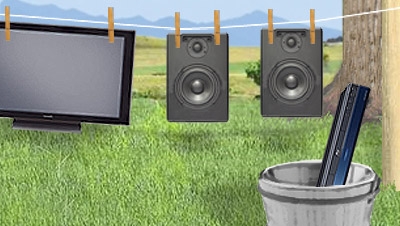No Dirty Dozen: 13 Spring-Cleaning Tips for Your Home Theater Page 2

4 Leads for Speakers
Speakers are the tough guys of the A/V world. They were around long before plasma and LCD TVs. Treat them right, and they'll be around long after those dainty displays are gone. Still, the nicest speakers usually have gorgeous finishes applied by highly trained and conscientious artisans. Some of the world's prettiest speakers originate from Lexington, Kentucky's Thiel Audio, which capitalizes on its proximity to the North Carolina furniture country by hiring away veneer masters who'd rather make speakers than clunky old-fashioned furniture. So who better to ask about speaker care than two Thielites: Customer Service/Tech Support Manager Gary Drayton and Customer Service Technician Rob Jones.
"We recommend nothing more than Endust or Windex - just spray it on a rag and wipe the speaker down," Drayton says. "Sometimes we get speakers in for refinishing that have been cleaned with something like Pledge that has silicon in it. That will leave silicon residue deep in the wood grain. It creates what refinishers call a 'fish-eye,' or a contamination spot in the wood. The finish will not stick to it, so it leaves a little dipped-in area."
"There's no way to test for it," Jones adds. "If someone's cleaned their speakers with something like Old English that has silicon, it doesn't show up until we put the new finish on it."
According to Drayton and Jones, piano-style black lacquer finishes benefit from the same type of care. "Generally, Windex is the best," Jones says. "Furniture polish will work on black lacquer, but it can leave a residue. That adds a wet look that's kind of nice, but it tends to result in fingerprints on the finish."
The grille fabric covering the speaker drivers is the speaker part you probably look at most - which is why you can't miss seeing all the dust and pet hair it attracts. "The best way to clean that is with compressed air," Drayton explains. "Most people don't have an air compressor, but you can take it to a gas station and blow it out with an air hose. You can also use the upholstery brush attachment on a vacuum cleaner." Will those handy compressed air cleaning cans work? "Sure," Drayton replies, "but with some of our larger speakers, you might go through a whole can on one grille."
Thiel designs its speakers to be used with grilles, but many companies don't. Jones says that the drivers on these speakers can be cleaned as long as their cones are made from aluminum or polypropylene, in which case a paper towel dampened with Windex will do the trick. He recommends against cleaning paper-cone drivers at all, and especially cautions against exposing them to moisture. These instructions apply only to woofers and midrange cones, by the way - dome midrange drivers and any type of tweeter can be damaged with the merest touch.
And those plastic speakers you got with your home-theater-in-a box system? Just wipe them down with a damp cloth if they get dusty.
1 Bit of Advice for Other Electronics
The myriad components in an equipment rack - A/V receivers, amplifiers, DVD and Blu-ray players, etc. - require the least care but are simultaneously the most susceptible to death at the hands of a wayward maid. According to Monster's Tim Pryde, "People often spray some sort of cleaner directly onto the electronics, and the moisture can get into some nook or cranny and short out the circuitry." He recommends nothing more than an occasional wipe with a clean dry cloth - such as the Clean Screen Kit's microfiber cloth, which Monster will start selling separately in April.
2 Tips for Connectors
Here's where we start to walk on the wild side of the audio industry. Because the connectors on the ends of cables are often made from different metals than the jacks or binding posts they're connected to, corrosion can occur and can actually impede the flow of electricity between cable and connector. Dedicated audiophiles regularly clean these contacts - and some even feel that different cleaning solutions yield audibly different results. (Here are two different cleaning-solution options: Needle Doctor and Parts Express.)
Thiel's Drayton and Jones note that in extreme situations - i.e., "speakers that have been in really nasty environments for 10 to 15 years" - sonically detrimental corrosion can occur. They recommend removing your cables every few years to check for corrosion - and if you spot any, to use De-Ox-It or any other good contact cleaner.
Of course, like so many other things in audio, one can take contact cleaning to extremes. Samsung's Mike Wood recalls a grueling regimen he had to endure while working as an assistant to a Los Angeles-based field recording engineer. "He had me go over all the connectors on the cables and equipment with Brasso, which is a metal polish. I'd have to let it dry, then wipe it off using Q-tips and pipe cleaners. This got rid of the oxidation. I'd then go at it with isopropyl alcohol to clean off any residue from the Brasso. Then I'd use Freon to clean off the alcohol. [This was the mid-1990s when you could still get Freon-based cleaners, which have been phased out due to environmental issues.] It was pretty extreme, but he told me that movie directors considered him one of the few people who could record useable sound on a set, so maybe there was something to it."




























































